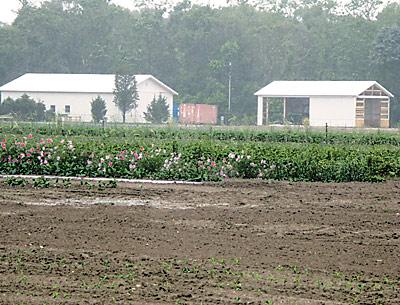New Babinski Barn Has Board in a Bog

A partially built barn in Wainscott, standing on land that community members and East Hampton Town paid to preserve, was the subject of a hearing at Town Hall last Thursday night and is presenting a legal quagmire.
After holding a hearing last week on whether to issue a construction permit for the barn, on the Babinski farm in Wainscott, the town board debated on Tuesday about how to proceed under a section of the town code that they agreed is outmoded and should probably be deleted.
The barn was approved by the planning board, and the building inspector issued a permit for it. Neighbors sued to overturn the planning board approval, however, and work on the barn, which is close to completion, was halted after a stop-work order was issued.
Because the town has purchased the development rights for the farmland on which the barn is being built, it was determined, according to a relevant section of the town code, that the town board must also sign off on the construction.
That part of the code, said Councilman Peter Van Scoyoc at the Tuesday work session, should be repealed. “I don’t think this is a necessary step for a farmer to have to go through,” he said. “There’s no criteria in the code by which to judge the appropriateness of the structure.” Although requiring a town board-issued permit, the code section in question does not lay out standards to help the board determine whether to issue it.
“We have a review process in place for agricultural buildings,” Mr. Van Scoyoc said. “This is a vestige, I believe, of a time when we did not have a review process.”
The law was adopted in 1982, said John Jilnicki, the town attorney, when the purchase of development rights was new. It was likely designed to ensure some degree of control over farm buildings on land the town had paid to preserve.
Now, he said, including the Babinski purchase, the deeds transferring development rights spell out conditions. In the Babinski case, the agreement designated a four-acre portion of the acreage where agricultural buildings would be confined, and established a 30-foot setback limit along three sides of the area.
At last week’s hearing, Andy Babinski, whose son is farming the land, said that “never was structure placement an issue.” A requirement that precluded the farmers from putting up an agricultural building in the most convenient section of the four acres, he said, would have been “a definite devaluation of the land’s value,” and would have prompted the family to ask for more money for the development rights.
Alex Balsam, a farmer and an attorney, said at the hearing that farmers who sell the development rights on their land transfer only that, and not the right to farm the property or put up agricultural buildings. Requiring a permit from the town board to do so, he said, is “nothing more than a tool of harassment against the farmer.”
William Babinski, who obtained both planning board and architectural review board approval for the barn, “has done everything, and more, that the law requires,” said his attorney, David Eagan. “And then to have, at best, an unenforceable provision to be enforced for the first time in the history of the town — that’s just plain wrong.”
But Tom Gilbert, a neighbor of the Beach Lane farm and the plaintiff in the lawsuit against the planning board’s approval, argued that public money, plus private contributions from the neighbors, including $20,000 from his own family, had been spent and that the town should exercise some oversight.
“We think that the function of the town in these circumstances is to provide a balanced solution, to balance the needs of the neighbors and the farmers and the community,” making sure, he said, “that we’re not disproportionately being penalized by virtue of the fact that all the barns are being just dropped in front of our property.”
“That’s our primary view; obliterating our view, essentially,” Mr. Gilbert said. “We don’t think this is an appropriate use of the rights — really collective rights, now.”
“The town did not relinquish regulatory control” when it spent $7 million on the development rights, Jeffrey Bragman, Mr. Gilbert’s attorney, said, asserting that the town board must follow the existing town code “unless and until a court of law tells you it’s improper.”
The town board’s discussion on Tuesday centered on what exactly is required by law. Councilwoman Theresa Quigley suggested that the board not make its own decision on the building permit, but said instead that the planning board review, and the discussion by the 2005 town board when forging the agreement with the Babinskis, constitutes the required review.
However, “there is no legal basis for that,” Mr. Jilnicki said. In order to make the case that the board’s legal obligation has already been met, it would have to review a transcript of the 2005 public hearing on the development rights purchase.
“It seems to me this guy has gone through enough process,” Ms. Quigley said of Mr. Babinski. “I believe that we should take a step that does whatever we can to get them out of this litigious morass they’re in.”
“I think the fact is, there will be a lawsuit whatever we do,” Mr. Van Scoyoc said, “and I don’t see where following the code is the least defensible. I don’t think that a town board can simply ignore a section of the code that requires a process.”
Councilwoman Sylvia Overby suggested that the board simply issue the construction permit. Ms. Quigley disagreed, and Councilman Dominick Stanzione asked for time to review the 2005 board discussion.
An earlier version of this story misidentified Alex Balsam as being recently appointed to the East Hampton Town Planning Board. He is not a member.
